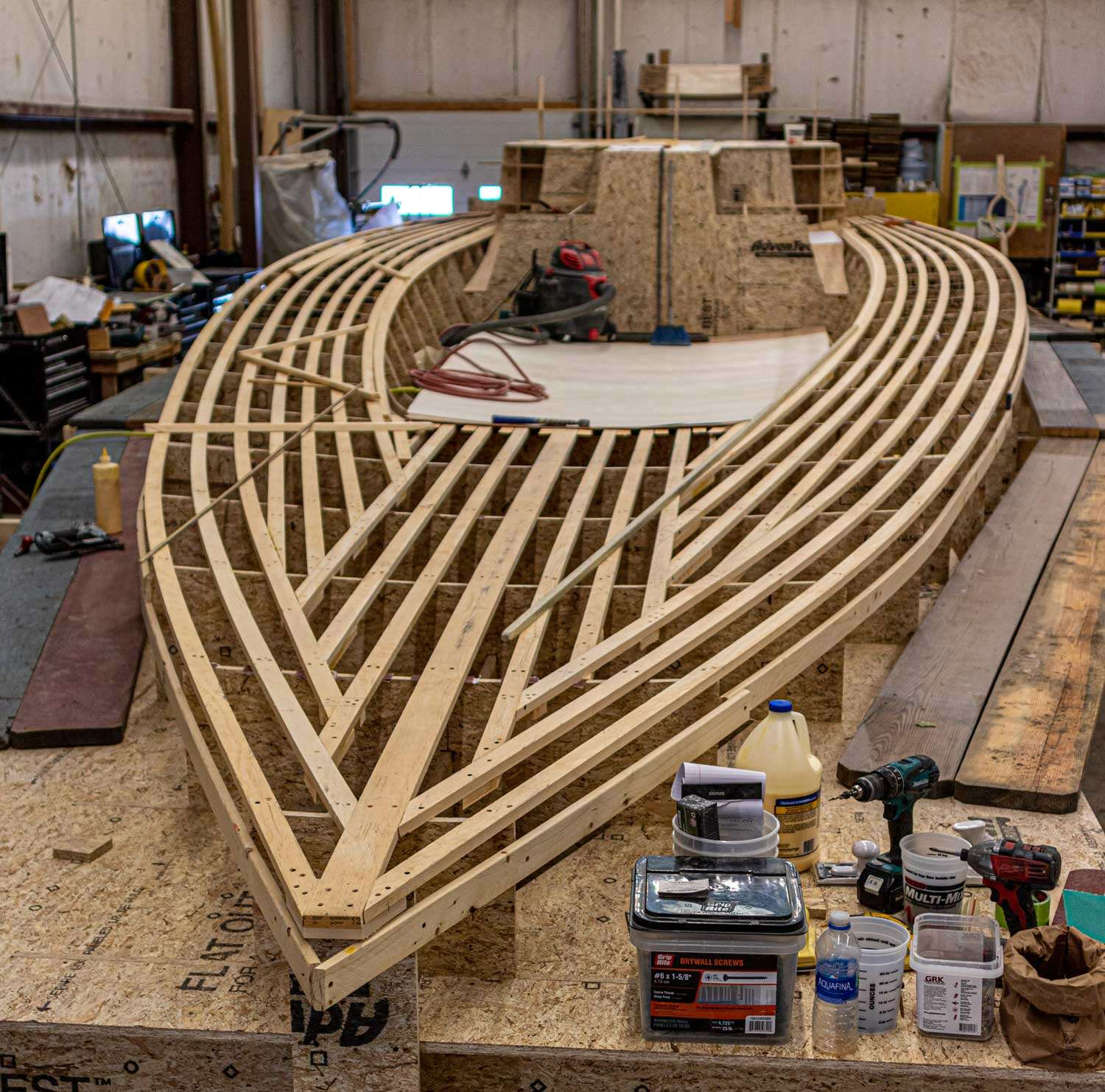
Processing Your Payment
Please do not leave this page until complete. This can take a few moments.
- News
-
Editions
View Digital Editions
Biweekly Issues
- December 1, 2025
- Nov. 17, 2025
- November 03, 2025
- October 20, 2025
- October 6, 2025
- September 22, 2025
- + More
Special Editions
- Lists
- Viewpoints
-
Our Events
Event Info
Award Honorees
- Calendar
- Biz Marketplace
Undeterred by pandemic, Lyman-Morse 'full steam ahead' on new sailboat build
 Courtesy / Joshua Moore/Lyman-Morse
Lyman-Morse employee Val Harris laminates Douglas fir hull frames on hull No. 1 of the LM46, a new yacht design under construction at Lyman-Morse Boatbuilding in Thomaston.
Courtesy / Joshua Moore/Lyman-Morse
Lyman-Morse employee Val Harris laminates Douglas fir hull frames on hull No. 1 of the LM46, a new yacht design under construction at Lyman-Morse Boatbuilding in Thomaston.
Lyman-Morse Boatbuilding Inc., a boatbuilding company in Thomaston, began construction of a new sailboat model just before the pandemic hit.
Hull No. 1 of a new “performance cruiser” called the LM46 is under construction and is expected to launch this fall, according to a news release.
The project is a collaboration between Lyman-Morse founder Cabot Lyman, his son and company President Drew Lyman and New Zealand designer Kevin Dibley.
“The goal for the LM46 is simple: To have you sailing within five minutes of stepping aboard, and to be able to step off within five minutes of picking up your mooring,” Cabot Lyman said in the release.

The project remains “full steam ahead” and has garnered queries from at least a couple of potential buyers, Drew Lyman told Mainebiz.
The boat is designed for customers who enjoy both cruising and racing, he explained.
In general, a performance cruiser is a type of sailboat targeting customers who envision a chance to have a relaxing cruise with family and friends but who also want to achieve enough speed to make their mark in sailboat races.
The LM46 has a “high-performance” hull design that’s “not a racing sled, but if design weights are honored, the team expects speeds of 10 plus knots under sail,” according to the release. The speed is helped by a sailing rig that includes swept-back spreaders and 1,183 square feet of sail.
Equally important, the LM46 was designed to be responsive in light air. Features such as a big spade rudder made from lightweight carbon fiber are meant to provide excellent control.
The boat will be equipped with an 80-horsepower Yanmar diesel engine
Innovation
Drew Lyman, a 2016 Mainebiz Next List honoree, grew up at the yard founded in 1978 by his parents, Cabot and Heidi Lyman, and became president in 2012.
The company is known for its cold-molded and composite high-end yacht construction, and also provides service, storage and refits. It specializes in composites, advanced composites and aluminum construction.
Lyman expanded the company’s technical and metal fabrication portfolio beyond marine environment products and in 2015 acquired Wayfarer Marine in Camden.
He views innovation and diversification as key to keeping pace in an industry vulnerable to economic ups and downs.
As it happened, the LM46 was conceived about a year ago, well before today’s economic meltdown. The idea, he said, builds off a previous sailboat, the Lyman-Morse Seguin 44, developed by Cabot Lyman and his partner at the time, Roger Morse, in the 1980s. The Seguin hit the market at a time when the boatbuilding industry was transitioning from custom to production work in an effort to lower cost and appeal to a larger market, the company’s history says.
Fifteen of the Seguin 44s were built; Seguins in other sizes were also built.
“It was very successful,” said Lyman.
In the 1990s, the company turned to customized powerboat and sailboat construction of various designs and materials. Since 1978, it’s turned out more than 100 yachts, including carbon fiber catamarans, traditional cruising sailboats, carbon racing sailboats and motor yachts.
The LM46 is a return to production boatbuilding, said Lyman.
“It implements a lot of the modern things we’ve developed in the last 20-plus years,” he said.
The yacht is being built using the “cold-molded” method of construction. A cold-mold construction is built from wood veneer that’s strategically layered and affixed with epoxy, according to smalltrimanddesign.com.
For the LM46, the technique combines the ambiance of a wooden hull — in this case, Douglas fir and western red cedar — with a high level of performance, according to the release. The structure is expected to be resilient and strong while delivering a quiet ride. A layer of fiberglass on the topsides is expected to increase durability and reduce maintenance.

Construction techniques include the use of Lyman-Morse’s Haas GR712 computer numerical control (CNC) router, 3D printer, plasma cutter and other hi-tech CNC machines to cut planks, bulkheads, custom metal components, detailed trim pieces and joinery. The machines make it possible to cut pieces to precise specifications, and less labor-intensive than traditional hand-built methods.
Also, whenever possible, items for the LM46 are built as modular units outside the boat, which also saves time and money. All Lyman-Morse boatbuilding projects start with a full-size mockup.
The customer pool, said Lyman, is expected to be someone looking for a high-performance boat that also has a high-quality interior.

“The mission for this boat was to bring more soul to the world of production boats,” he said.
The pandemic slowed down operations somewhat, as a few employees took time to take care of themselves and their families, he said. The yard, which employs over 100 people, implemented split shifts and reduced hours when the pandemic struck, he added.
But the company is almost back up to speed now, with guidelines in place on how to conduct business in the yard.
The company has two other new builds under way: a 35-foot powerboat and a 57-powerboat.
“So we’ve got a lot of work for the next year,” he added. “We’re in a good position.”
Mainebiz web partners
Related Content

The Giving Guide
The Giving Guide helps nonprofits have the opportunity to showcase and differentiate their organizations so that businesses better understand how they can contribute to a nonprofit’s mission and work.
Learn More
Work for ME
Work for ME is a workforce development tool to help Maine’s employers target Maine’s emerging workforce. Work for ME highlights each industry, its impact on Maine’s economy, the jobs available to entry-level workers, the training and education needed to get a career started.
Learn More
Groundbreaking Maine
Whether you’re a developer, financer, architect, or industry enthusiast, Groundbreaking Maine is crafted to be your go-to source for valuable insights in Maine’s real estate and construction community.
Learn more-
The Giving Guide
The Giving Guide helps nonprofits have the opportunity to showcase and differentiate their organizations so that businesses better understand how they can contribute to a nonprofit’s mission and work.
-
Work for ME
Work for ME is a workforce development tool to help Maine’s employers target Maine’s emerging workforce. Work for ME highlights each industry, its impact on Maine’s economy, the jobs available to entry-level workers, the training and education needed to get a career started.
-
Groundbreaking Maine
Whether you’re a developer, financer, architect, or industry enthusiast, Groundbreaking Maine is crafted to be your go-to source for valuable insights in Maine’s real estate and construction community.
ABOUT
NEW ENGLAND BUSINESS MEDIA SITES
No articles left
Get access now
In order to use this feature, we need some information from you. You can also login or register for a free account.
By clicking submit you are agreeing to our cookie usage and Privacy Policy
Already have an account? Login
Already have an account? Login
Want to create an account? Register
Get access now
In order to use this feature, we need some information from you. You can also login or register for a free account.
By clicking submit you are agreeing to our cookie usage and Privacy Policy
Already have an account? Login
Already have an account? Login
Want to create an account? Register











0 Comments